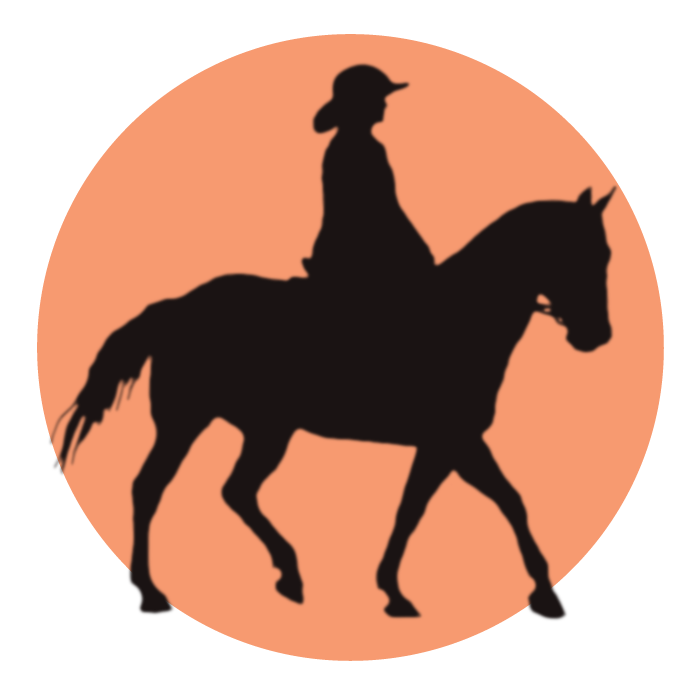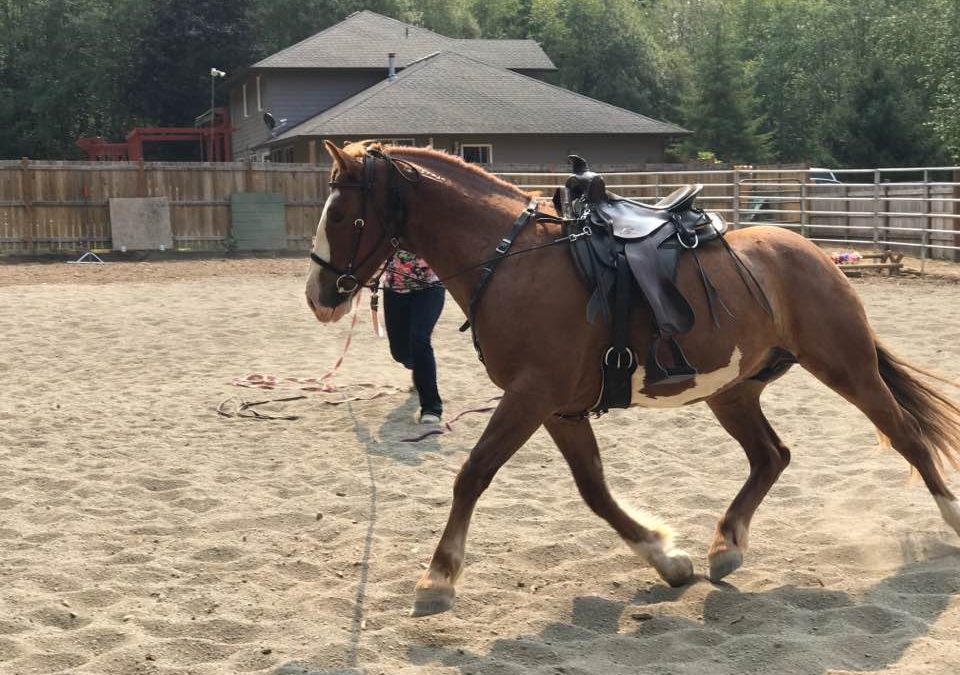If you’ve ever watched horses running around in the wild you’ll see that most of the time they lean opposite the direction of their turns (called a counter-bend). This is natural for them and a way they balance their bodies. When we ride them this isn’t so good. Their natural tendency is to counter-bend, but when we’re on their backs and going around in a circle our weight displacement causes undue stresses on their legs and backs – sheer stresses that over time compromise the healthy functioning of their joints and back muscles. So, we need to teach them how to carry us when doing circle work. There are lots of ways to go about this and a good trainer/instructor can work with you and your horse on some different exercises that will help. I’ve listed below a few methods that will get you started.
ON THE GROUND:
Working with your horse in-hand (i.e. on the ground) is a good way to teach him to respond to leg pressure, and to be respectful of it. The primary two things any horse should be taught when he’s started is to move his feet with some cue (usually a cluck) and to move away from pressure. If your horse doesn’t know these things – start here (and read my other article on halter work with your horse – Pressure, Release & Timing)!
Standing near your horse and facing his shoulder, tip his face in slightly to you and with the blunt end of a crop or longe whip apply a small pressure to the girth area, where you would put your leg or spur. Hold this pressure steady and just wait. If your horse steps sideways, away from the pressure – release the pressure (don’t follow him with it!) and reward him with pets and praise. Do this several times on each side and on a daily basis until your horse steps sideways and away from you the moment you apply pressure to his girth area. If your horse moves into you when you first apply pressure, get after him suddenly and with lots of energy…I usually stomp my feet, make lots of loud noise and thrash my arms around his shoulders. He’ll probably really scoot from you but that’s okay…you just taught him that there are serious consequences for invading your space when not invited. Sometimes this doesn’t work with aggressive or dominant horses. In this case I’ll reinforce my stomping and loudness by either a smart smack with the whip end to the underside of the girth area or a rap to the shins (the canon bone area) with the whip end. That’s usually enough to make them quickly get out of your space! Then, let your energy mellow out and go right back to the slight pressure to the girth area with the blunt end of the whip. Repeat….using the “scare away” tactic if he moves into you or praising if he moves away from you. Remember not to increase that pressure while you’re waiting. Let it be his choice to move away from an annoying pressure rather than a necessity to move away from a painfully increasing pressure. Choice is what we’re looking for here! Make the right choice (i.e. move body away from you), get a reward. Make the wrong choice (i.e. move body into you) and get negative heightened aggression. Make no choice (i.e. just stand there) and put up with an annoying pressure until eventually a choice needs to be made (just wait this out – it may take a bit!). Also, remember to keep the horse’s nose slightly tipped into you. This helps him;
1. stretch the muscles on the opposite side of his body when he moves away from you and thus starts to condition his body and back muscles for this kind of lateral flexion and movement, and
2. prevents him from locking his neck, pulling away from you and possibly kicking out at you with his hind feet.
ON THE LUNGE LINE:
There are a few basic rules or concepts to practice when longing a horse. If you’re longing your horse to get the “bucks” out of him before you ride then;
- Your horse is not getting enough outdoor exercise time and
- Your horse lacks respect for you as the leader (see my article – The Leader Role)
These issues can be solved by turning your horse out more often and better training/working on your leadership role with your horse.
Longing your horse should be done with a purpose in mind – some kind of training exercise to teach him something that might be harder to do if you’re on his back initially. Don’t longe mindlessly – it’s a waste of time and it accomplishes nothing other than possibly allowing your horse to learn some bad behaviors.
When longing to correct counter-bend, use a small circle. Use your longing whip to push the horse’s shoulder (flick the whip at his shoulder) out and to keep the longe line taut. Apply intermittent pressure and release on the horse’s longing cavesson or halter (his nose basically) to encourage the flexion of his neck and the tip of his head to the inside of the circle. Drive his back end up underneath him with the encouragement of the longing whip by pointing the whip at his hip. You’ll have to get pretty handy at moving your longe whip smoothly between his shoulder and hip. What you’re looking for is an upright horse, not one who is leaning in, dropping his inside shoulder and tipping his head to the outside. You encourage the lift of his inside shoulder by pushing it out and keeping the head tipped in. And in order to do this successfully you need to keep forward momentum going (thus the encouragement with the whip at the horse’s hip). When the horse lifts his inside shoulder he’ll be forced to place his inside hind foot more to the inside and under him. Because of the small circle, be sure to only do this work at a trot in the beginning. Don’t do these exercises for long periods of time because your horse’s muscles have to develop over time so he can carry himself correctly and not get sore. Once a horse’s muscles are conditioned, he can be worked at a canter in the smaller circle but keep the sessions short as this does put strain on his legs.
IN THE SADDLE:
When riding your horse on the rail in the arena you can help him get the correct bend by doing several things. To correct counter-bend using the reins and your leg aids, widen your hands – a lot! Think of the outer boundaries of your hands as the “box”. Your horse’s shoulders move within this “box” area. The wider your “box” the more room you give for your horse’s shoulders, thus preventing him from locking them up. With your hands wide, move your whole box over to the outside. Essentially this means your outside rein is a distance away from the horse and your inside rein in almost up against his neck. Apply a give and take pressure to the inside rein (elastic contact), directing that pressure back, slightly upwards and toward your outside hip (this is called the indirect rein). Be sure to also sit up straight in the saddle with a little more weight in your outside …how to say this gracefully… buttock cheek. This intermittent pressure and release of the inside rein should soften your horses mouth, get him to give at the poll and help to tip his head ever-so-slightly to the inside. Your outside rein should have a steady, constant, supportive pressure (it is called the supporting rein). This prevents the horse from turning into the circle. As you apply the intermittent pressure (like a massage) on that inside rein you should also use pressure with your inside leg against the girth. Now the horse (who has been taught to move away from pressure) can bend his body slightly out, he has room to move his shoulders to the outside, the indirect rein helps to lift the inside shoulder and shift that weight to the outside shoulder which then helps to free up his inside hip enabling that inside hind leg to step under his body. And your horse is upright, correctly bent (or rather just carrying his weight better in the circle, more to the outside, because you don’t want to encourage your horse to be crooked). So really, think of it as adjusting your horse’s shoulders in the circle and lifting them up, especially that inside one – which when dropped causes your horse to counter-bend.
Some great exercises to do are figure eights, lots of small and large circles off the rail and circle work that slowly spirals in then spirals back out with the use of the leg aids to help move the horse into a tighter circle then a looser and bigger one. Remember to not constrain the movement of the horse’s shoulders with tight, close-together hands. Keep your hands wide and loose and allow the horse to move around in the box you create with your hands.
Working with your horse on the ground, on a longe line and in the saddle with some of the suggested methods above should help him become supple, responsive, carry you correctly and with balance on the circle and eliminate the dreaded counter-bend.


Recent Comments